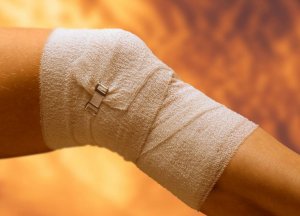Cycling Injuries

Cycling is a sport that brings many benefits to your health. However, just like any other discipline, it carries a risk of potential injuries. Next, we’ll talk about the most common cycling injuries and how you can prevent them.
Factors that cause cycling injuries
Many cycling injuries are due to bike malfunctions
And we’re not just talking about malfunctions that can happen accidentally, such as broken parts or wear and tear. It’s also important to know how each part of the bike works and to choose the right bike according to your physical needs and the type of cycling that you practice.

Among the most common injury causes are:
- Wrong bike seat height: you should be able to extend your legs and bend your knees properly. While you’re at rest, your leg should maintain a 160 degree angle, and when it’s bent, it should form a 25 or 30 degree angle.
- Anatomical alterations: if you suffer from any knee or leg deformities, or if your legs are bent in a certain way (such as with genu valgum or varum), you must use special equipment and adapt your bike to fit your needs.
Cycling can also be related to the same issues that regular workouts have: over-training, poor diet, training with too much weight or for excessively demanding periods and using bad techniques.
Types of cycling injuries
After analyzing the factors that could lead to cycling injuries, let’s look at the most common injuries of this discipline and what they are.
Traumatic injuries
This may be the first type of injury that comes to mind for any beginner. It doesn’t matter how much experience a rider has or how skilled they are: there’s always a risk of falling. It even happens in the Tour de France.
These types of injuries usually affect your wrists, elbows and knees. Depending on the intensity of the impact and your age, you may also hurt your collarbone and ribs.
Neck pain
Neck pain is very common in bike riders because of the angled position that they must stay in. When you’re riding through uneven terrain, your spine and shoulders absorb all of the impact from the bike. And the symptoms may increase, because you must lift up your eyes to look at the road.
Lumbar problems
If the handle is not at the right height, your posture may be affected. This can cause discomfort in your lower back or lumbar region.
Expert riders claim that the perfect angle for your spine is at 110 degrees. If you lean in too much or you don’t lean in enough, you can hurt your back, especially if you’re making a big effort.
Hand injuries from too much strain
In many cycling modalities, the ground is uneven and has a lot of pits and holes. The rider must grab the handles firmly to avoid falling off the bike.
This vibration can cause your hands to swell or even break, because of all the pressure they are under. It can also cause carpal tunnel syndrome, which affects the nerves that run through the center of your wrists and causes a tingling sensation on your phalanges.
Lower body injuries
The perineum is usually the most affected body part because it has to carry heavy loads for long periods of time while you train and compete. It doesn’t just absorb the impact, it’s also under constant friction. Sweating in that area can cause different skin conditions and problems.
Patellar tendinitis
Patellar tendinitis is a common problem for riders. This tendon allows the muscles in the front portion of your thighs to move your knees. Obviously, this is a constant movement while riding a bike.
The lower part of the kneecap, or the tendon itself may be affected. It can be due to a deviated traction, or more commonly, an overuse injury.
The solution to this problem is closely related to the cause itself, and you can avoid this by aligning your feet correctly.
Other types of tendinitis

While patellar tendinitis is the most common one, there are other tendons that can swell and cause you pain. For example:
- Quadriceps tendonitis: causes pain on the upper part of the kneecap. It’s usually due to an inadequate seat height, whether it is too low or too high.
- Pes anserinus tendonitis: causes pain on the inner part of the knee, where the three muscles come together and attach to the tibia. It’s due to an excessive stretching of the knee, because of inadequate seat height.
- Hamstring tendonitis: can make you feel tension on your hamstrings and pain in the back of your knees.
- Achilles tendonitis: overloading this tendon can cause pain. To fix it, you must change the position of the pedals and in some cases, even change your shoes.
Just as with any other sport, cycling injuries are closely related to specific characteristics and requirements. Therefore, it’s important to take the necessary precautions to fix these possible causes and maintain a good health level while cycling.
Cycling is a sport that brings many benefits to your health. However, just like any other discipline, it carries a risk of potential injuries. Next, we’ll talk about the most common cycling injuries and how you can prevent them.
Factors that cause cycling injuries
Many cycling injuries are due to bike malfunctions
And we’re not just talking about malfunctions that can happen accidentally, such as broken parts or wear and tear. It’s also important to know how each part of the bike works and to choose the right bike according to your physical needs and the type of cycling that you practice.

Among the most common injury causes are:
- Wrong bike seat height: you should be able to extend your legs and bend your knees properly. While you’re at rest, your leg should maintain a 160 degree angle, and when it’s bent, it should form a 25 or 30 degree angle.
- Anatomical alterations: if you suffer from any knee or leg deformities, or if your legs are bent in a certain way (such as with genu valgum or varum), you must use special equipment and adapt your bike to fit your needs.
Cycling can also be related to the same issues that regular workouts have: over-training, poor diet, training with too much weight or for excessively demanding periods and using bad techniques.
Types of cycling injuries
After analyzing the factors that could lead to cycling injuries, let’s look at the most common injuries of this discipline and what they are.
Traumatic injuries
This may be the first type of injury that comes to mind for any beginner. It doesn’t matter how much experience a rider has or how skilled they are: there’s always a risk of falling. It even happens in the Tour de France.
These types of injuries usually affect your wrists, elbows and knees. Depending on the intensity of the impact and your age, you may also hurt your collarbone and ribs.
Neck pain
Neck pain is very common in bike riders because of the angled position that they must stay in. When you’re riding through uneven terrain, your spine and shoulders absorb all of the impact from the bike. And the symptoms may increase, because you must lift up your eyes to look at the road.
Lumbar problems
If the handle is not at the right height, your posture may be affected. This can cause discomfort in your lower back or lumbar region.
Expert riders claim that the perfect angle for your spine is at 110 degrees. If you lean in too much or you don’t lean in enough, you can hurt your back, especially if you’re making a big effort.
Hand injuries from too much strain
In many cycling modalities, the ground is uneven and has a lot of pits and holes. The rider must grab the handles firmly to avoid falling off the bike.
This vibration can cause your hands to swell or even break, because of all the pressure they are under. It can also cause carpal tunnel syndrome, which affects the nerves that run through the center of your wrists and causes a tingling sensation on your phalanges.
Lower body injuries
The perineum is usually the most affected body part because it has to carry heavy loads for long periods of time while you train and compete. It doesn’t just absorb the impact, it’s also under constant friction. Sweating in that area can cause different skin conditions and problems.
Patellar tendinitis
Patellar tendinitis is a common problem for riders. This tendon allows the muscles in the front portion of your thighs to move your knees. Obviously, this is a constant movement while riding a bike.
The lower part of the kneecap, or the tendon itself may be affected. It can be due to a deviated traction, or more commonly, an overuse injury.
The solution to this problem is closely related to the cause itself, and you can avoid this by aligning your feet correctly.
Other types of tendinitis

While patellar tendinitis is the most common one, there are other tendons that can swell and cause you pain. For example:
- Quadriceps tendonitis: causes pain on the upper part of the kneecap. It’s usually due to an inadequate seat height, whether it is too low or too high.
- Pes anserinus tendonitis: causes pain on the inner part of the knee, where the three muscles come together and attach to the tibia. It’s due to an excessive stretching of the knee, because of inadequate seat height.
- Hamstring tendonitis: can make you feel tension on your hamstrings and pain in the back of your knees.
- Achilles tendonitis: overloading this tendon can cause pain. To fix it, you must change the position of the pedals and in some cases, even change your shoes.
Just as with any other sport, cycling injuries are closely related to specific characteristics and requirements. Therefore, it’s important to take the necessary precautions to fix these possible causes and maintain a good health level while cycling.
This text is provided for informational purposes only and does not replace consultation with a professional. If in doubt, consult your specialist.








